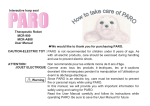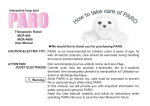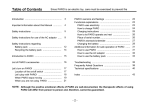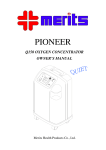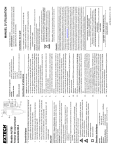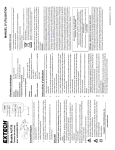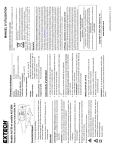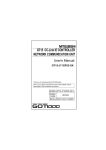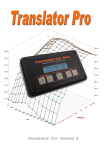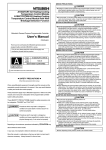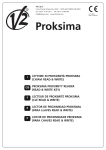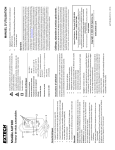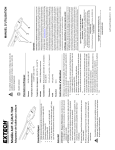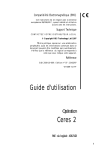Download We would like to thank you for purchasing PARO. CAUTION
Transcript
Interactive harp seal Therapeutic Robot MCR-900 MCR-A888 User Manual ◆We would like to thank you for purchasing PARO. CAUTION-ELECTRIC TOY : PARO is not recommended for children under 8 years of age. As with all electric products, care should be exercised during handling and use to prevent electric shock. Non recommandé pour les enfants moins de 8 ans d'âge. ATTENTION: JOUET ELECTRIQUE Comme avec tous les produits é lectriques, les pr é cautions devraient être remarquées pendant la manipulation et l'utilisation pr évenir le décharge électrique. ! Warning Since PARO is an electric toy, care must be exercised to prevent fire or personal injury while using PARO. In this manual, we will provide you with important information for safely using and caring for PARO. Read the User Manual carefully and follow its instructions while operating PARO. Be sure to save the User Manual for future Functional explanations PARO uses electricity ◆Feeding PARO Real harp seals eat fish, but PARO needs electricity to operate. If PARO's batteries are not charged enough to operate, PARO will stop moving. When the charge in the battery is low, PARO will move to show you it is hungry. When this happens, you can charge PARO by using the AC adaptor. As well, when PARO is left alone for some time while it is on, will stop moving. PARO will rest in order to conserve the charge in its battery. When PARO is resting, you can make it move again by touching its back or providing some other form of stimulation. Turn off PARO’s switch when you are not using PARO. The switch is located between PARO’s hind flippers. (Refer to page 17.) ◆How long can PARO keep moving? The length of time the battery can support physical movement is about 5 hours, although the exact time depends on the amount of interaction with PARO. ◆When PARO gets hungry (The battery is losing charge) When the battery loses most of its charge, PARO will call out twice to express its need to have its batteries recharged. When the batteries are completely discharged, PARO will turn off automatically. ◆You can use PARO even if its batteries are not charged. When the battery is fully discharged you can still use PARO at any time by plugging in the AC adaptor. When you use PARO with the AC adaptor plugged in, PARO will not get hungry. In that case PARO can work continuously. However, turn the switch off and let PARO have a rest when you are not interacting with PARO. Notice When you are leaving PARO alone for a long period of time, make sure the AC adaptor is unplugged. - 23 - Functional explanations How to charge PARO ① Turn PARO off. ② Plug the AC adaptor into the wall. The POWER lamp will go on. ③ Pull off the safety-cap on the jack and place it into the receptacle inside PARO's mouth. When the CHARGE light is on, PARO is being charged. When the CHARGE light goes off, PARO is completely charged. CHARGE lamp Plug POWER lamp Safety cap Pacifier-shaped plug - 24 - Functional explanations Charging instructions ・When the battery pack gets hot due to extended use of PARO, the battery will not charge. This is done to protect the battery pack from overheating. ・The CHARGE light may go off, even when charging has not been completed. If this happens, try unplugging the pacifier jack from PARO’s mouth and then plug it in again. Charging should then resume until it is completed. ・When PARO is operating with the AC adaptor plugged in, PARO will not charge. Charging only occurs when PARO is turned off. ・When PARO is plugged into the AC adaptor, it will not recharge so long as PARO is working. PARO works by getting electric power through the AC adaptor. Even when the batteries are not charging, the CHARGE light will illuminate. ※ It blinks on and off according to PARO’s movement. It is not because of a failure. ・Discharge PARO's battery completely before you recharge PARO. ・It takes about 3 hours to charge the battery from empty to full. - 25 - Functional explanations How to let PARO operate and rest (switch ON, switch OFF) ◆How to make PARO operate. ・Turn PARO on by pressing the on/off switch for 1 second. ・If PARO does not move when the switch is turned on, pet PARO on its back and PARO will wake up. ◆How to let PARO rest. ・Press the switch for 3 seconds. PARO will move into a sleeping position and call in a quiet voice, signifying it will stop operating, and go to sleep. Place of serial number (manufacturing number) Place where the serial number was stamped. ・Fancy box (box on which the photo of PARO is printed) side surfaces. ・・・ Please refer to the diagram on the right side. ・PARO main body・・・Please refer to p. 27,28. There is one serial number for each PARO; you will need this serial number when you wish to get support. ※When we receive requests for support, this number will be used for owner referral, so please check the number before making any request for support. Fancy box (box on which the photo of PARO is printed) Side surfaces place where the serial number was stamped. - 26 - Functional explanations PARO’s stomach / underside ① Volume control switch The volume of PARO’s voice is adjustable: press the ‘Up’ switch to make it louder and the ‘Down’ switch to make it softer. Whenever you press a volume control switch, PARO will call with the adjusted volume. ② Battery pack housing base ※For installing and removing the battery pack, please refer to p.29,30. ③ Location of marked serial number It is a production number for each PARO and necessary when you have any services. This number is marked on the fancy box other than PARO's abdomen area. ①∼③ are covered by a lid. Please open the lid when you need to see the serial number. Initialization of the memory: You can reset PARO’s memory to the factory default at any time by pressing the ‘Up’ and ‘Down’ volume control buttons at the same time for about 3 seconds. The reset is complete after two ‘bleep’ sounds. Notice If you reformat the memory, everything PARO has already learned will be completely erased. - 28 - Functional explanations Changing the battery (Replacement instructions) The battery pack inside PARO will last about 2 year. The capacity of the battery to hold a charge will gradually decrease over time. We recommend that you replace the battery pack after using it for 2 year. 1. Turn PARO off by pressing the on/off switch between PARO’s hind flippers. Wait until PARO stops moving. ※If the AC adaptor is plugged in, unplug it. 2. Turn over PARO’s body , open the fastener and open the battery lid. To open the battery compartment lid, press the plastic hook and pull the lid off. A lid is opened and removed. Battery lid Hook - 29 - Additional information for safe operation of PARO In order to safely use PARO and prevent damage to PARO and the AC adaptor, you should follow these guidelines: ◆ How to use PARO ・Do not use PARO in places where it may be dropped or shaken, or on unstable surfaces. ・Do not touch or squeeze PARO too hard, such as leaning on it with your elbow. ・Do not hit or drop PARO, as it will cause damage. ・The power may turn off following a strong impact or when the unit is dropped. Please press the power button again to restart. ・Do not hold PARO up, twirl or twist it by its head or flippers. ・Do not leave PARO in hot places, such as in bright sunlight or in a closed car. ・Do not put foreign materials in PARO's mouth. ・Do not use PARO outdoors where it could be exposed to water or other foreign materials that could damage PARO. ・Do not put PARO in water. ・Do not put stickers on PARO's nose or eyes. ・Do not interfere with or restrict PARO’s movements in any way. ・Do not disassemble or modify PARO. ・When you transport PARO, place it in a shock absorbing container, such as the box it was delivered in, so that you do not damage PARO’s head, body, or flippers. ・Do not put PARO in a microwave oven or X-ray machine. ・When you use PARO, make sure your hands are clean. The artificial fur may otherwise get dirty and will be difficult to clean. ◆ Condensation on PARO When you move PARO quickly from a low temperature to a high temperature location, the water vapor becomes liquid and condensation occurs. Do not use PARO when you move it from hot to cold places. Wait an hour before switching PARO on, as the condensation inside PARO can cause damage. - 31 - Additional information ! Warning ◆ How to use the AC adaptor ・Use only the AC adaptor provided in PARO's box. If you use a different AC adaptor, it will not charge PARO and may cause damage or fire. ・Do not separate the AC adaptor into parts or modify it. ・Do not connect the AC adaptor when you are in a foreign country using a AC adaptor. It can cause overheating and will damage PARO. ・Never leave the AC adaptor in the following places, even for storage, as it can damage the adaptor. ◇Places that are hot. ◇Direct sun light or other heat source. ◇Places with intense vibration. Places with powerful magnetism. Sandy or dusty conditions. ・Sand and dust can cause serious damage to PARO. ・Do not drop the AC adaptor. ・Do not use the AC adaptor near TVs or radios, as it may interfere with reception. ・Do not pull the AC adaptor by its cord. ◆ When you use PARO while it is plugged in, PARO and the AC adaptor will get warmer. When you use PARO while it is plugged in, it is normal for PARO and the AC adaptor to get warmer. ◆ If PARO or the AC adaptor overheat, this may indicate that there is a problem. Immediately unplug the AC adaptor and remove the battery pack from PARO. - 32 - Additional information ! Warning ◆How to use the battery pack ・Do not leave the battery in a place where the temperature exceeds 100°F. ・Be careful not to allow anything to contact the battery terminals. ・When you do not use PARO for a long time, remove the battery pack and store it in a cool place. Recharge the battery pack when you haven’t used PARO for a long time. ・Do not drop the battery pack or put heavy articles on it. ・Do not apply strong force to the battery pack. ・Do not put the battery pack into a fire. Notice Maintenance of the AC adaptor ・If the AC adaptor case is soiled, wipe the casing with a dry soft cloth. If the case is still dirty, use a soft cloth lightly moistened with water to wipe the case. Dry the case immediately with a soft dry cloth. ・Do not use solvents of any kind as they may damage the AC adaptor. ・Do not leave the case in contact with rubber or vinyl objects for a long period of time, as they may cause the case to deteriorate. - 33 - Additional information Cleaning PARO's fur Basic equipment for PARO robot use and cleaning: ・Dapple toy cleaner (or comparable product) ・Wire brush ・Hand towels ・PDI Super Sani-Cloth Germicidal Disposable Wipes (or comparable product) ・Purell alcohol-based hand sanitizer gel (or comparable product) ・Although PARO’s artificial fur is made of antibacterial materials, it may get dirty. R R ・Daily cleaning routine is as follows: 1.Spray PARO's fur with Dapple cleanser 2.Gently wipe clean PARO's fur with towel, avoid area around eyes and nose 3.Wipe down PARO’s fur with PDI Super Sani-Cloth wipe. 4.Let PARO's fur dry as much as possible 5.Brush the entirety of PARO’s fur (brush in the direction of the fur) 6.Clean the brush ・ - 34 - Troubleshooting If you think PARO is not operating properly, please check the following table. If PARO does not work at all, it may be damaged. Please contact PARO Robots U.S., Inc. Problem ◆You pressed the on/off switch for 1 second and PARO did not turn on. ◆Even after charging, PARO does not work. ◆Front and hind flippers do not move. ◆PARO does not call out. ◆PARO does not operate shortly after unplugging the AC adaptor, even though the battery appears to be fully charged. Cause Battery is not charged. Solution Charge the battery (refer to page 24, 25). AC adaptor is not inserted correctly Plug in the AC adaptor (when using PARO correctly and press with AC adaptor plugged in). the on/off switch again. The on/off switch may not be Press the on/off switch in the ON position. between PARO's hind flippers for 1 second. (Refer to page 17.) There may be interference Put PARO with PARO's movements, on another surface. such as a thick pile rug or carpet. Volume may be too low. Adjust the volume (Refer to page 27). On occasion, the battery will not fully charge to prevent the battery from overheating. If this occurs, charge the battery again according to the charging directions. (Refer to page 24, 25.) If the battery is fully charged and PARO stops working soon after being unplugged from the AC adaptor, replace the battery pack. - 35 - Troubleshooting If you notice any abnormality in PARO or its accessories, such as those described below, it is an indication that using them further may be dangerous. Look at the table below to diagnose the problem and find a solution. Please also consult PARO Robots U.S., Inc. Problem Solution ◆ Damage to the electrical cord. The cord is no longer protected and there is a risk of shock. The rubber casing of the Unplug the cord from the wall socket immediately. electrical cord is damaged. ◆ The AC adaptor is wet. There is a risk of electric shock if you continue to use the AC adaptor. Unplug the AC adaptor from the wall socket immediately. ◆ PARO or one of its accessories PARO may turn off due to a sharp impact. In this case, stopped working after they were please turn it on again. dropped or pressed too firmly. If it still does not move, the base plate may be out of position or there may be a fault with an internal part. To avoid possible injury, please DO NOT attempt to dismantle PARO yourself. Return PARO to PARO Robots U.S., Inc. Do not attempt to disassemble PARO or its accessories, as there is a risk of electric shock and personal injury. ◆ Water is poured on PARO. Water can cause an electric shock if moisture gets into PARO. If water gets into PARO, immediately turn PARO off and remove the battery pack. - 36 - Troubleshooting If you notice any abnormality in PARO or its accessories, such as those described below, it is an indication that using them further may be dangerous. Look at the table below to diagnose the problem and find a solution. Please also consult PARO Robots U.S., Inc. Problem Solution ◆ Damage to the electrical cord. The cord is no longer protected and there is a risk of shock. The rubber casing of the Unplug the cord from the wall socket immediately. electrical cord is damaged. ◆ The AC adaptor is wet. There is a risk of electric shock if you continue to use the AC adaptor. Unplug the AC adaptor from the wall socket immediately. ◆ PARO or one of its accessories PARO may turn off due to a sharp impact. In this case, stopped working after they were please turn it on again. dropped or pressed too firmly. If it still does not move, the base plate may be out of position or there may be a fault with an internal part. To avoid possible injury, please DO NOT attempt to dismantle PARO yourself. Return PARO to PARO Robots U.S., Inc. Do not attempt to disassemble PARO or its accessories, as there is a risk of electric shock and personal injury. ◆ Water is poured on PARO. Water can cause an electric shock if moisture gets into PARO. If water gets into PARO, immediately turn PARO off and remove the battery pack. - 36 - Troubleshooting If you notice any abnormality in PARO or its accessories, such as those described below, it is an indication that using them further may be dangerous. Look at the table below to diagnose the problem and find a solution. Please also consult PARO Robots U.S., Inc. Solution Problem ◆ Abnormal sounds. ※This may occur when PARO's joints are damaged or have moved out of place. Turn PARO off and immediately remove the battery pack. Continued use of PARO could cause the problem to worsen. ◆ Abnormal smells, A short circuit may have occurred in the electrical circuit or there is smoke coming board or mechanical parts. out of PARO. This can cause a fire or electric shock if you continue to operate PARO. Immediately switch PARO off and remove the battery pack. ◆ PARO heats up Some damage has occurred. more than usual. Stop using PARO. - 37 - Frequently Asked Questions Question ◆ What should we do if PARO will not open its eyes and we cannot force them to open manually? Answer Do not try to open PARO's eyes manually. When PARO is resting, PARO closes its eyes. PARO should wake up when you pet it. If PARO does not wake up even after you have petted it, press the on/off switch to turn it off, and then turn PARO back on. If PARO still does not respond, there may be internal damage to PARO. ◆ After PARO has developed a character, can that character be changed? You can change PARO’s character by changing it’s environment and stimulus. Even if PARO has developed a character, it will continue to develop in response to its environment. Pet PARO gently and softly and call its name. ◆ PARO gets angry easily. How can I calm PARO down? Your gentle attitude will calm PARO down. ◆ PARO tends to stop moving. PARO will go to sleep if it receives no stimulus, Is this a problem? just like a real seal would. Pet PARO softly to wake it up. (When PARO is operating while plugged into its pacifier ◆ PARO does not respond and AC adaptor, PARO will not go to sleep.) when I call its name. PARO has some difficulty hearing long and complicated names. Is it upset? Please choose a short and clear name for PARO. PARO cannot hear voices when there is a lot of ambient noise. Call PARO’s name in a quiet environment. - 38 - Frequently Asked Questions Answers to frequently asked questions. Question ◆ PARO’s joints are noisy and its movements are jerky when it is moving around. Answer When a strong force is applied to its joints, PARO may move noisily or choppily to prevent the joints from being damaged. It is not actually damaged. ◆ PARO's artificial fur is dirty. Can we wash PARO? No, PARO cannot be washed. Wipe PARO with a soft cloth. If there is any dirt that you cannot remove, you can send PARO in for its artificial fur to be replaced for a charge. - 39 - Technical specifications PARO CPU Joints Fur Hearing Vocalization Internal sensor Electric power Operation time Size Weight Operation temperature Operation humidity Storing temperature Storing humidity 32bitRISC Processor Eye (eyelids), Head, Front flippers, Hind flippers Antibacterial (top layer) Microphone Speaker Tactile sensor (located in head, chin, torso (top, belly), front and hind flipper) Whiskers, Light sensor, Position sensor, Temperature sensor about 9W about 5 hours (when the battery is fully charged) about 350 x 160 x 570mm (1325/32 x 69/32 x 227/16 inches) (width * height * length) about 2.55kg (including the battery pack) (5.62lb) 41°F ∼ 95°F 40% ∼ 85% -4°F ∼ 140°F 10% ∼ 90% (except for condensation and ice) - 40 - Technical specifications AC adaptor Input Output Operation temperature Operation humidity Storing temperature Storing humidity Size (without the cord) Weight Length of the cord AC120V 60Hz 25W DC 18V, 1.1A 32°F ∼ 95°F 20% ∼ 90% -4°F ∼ 167°F 20% ∼ 90% (except for condensation and ice) around 60 x 35 x 160mm (23/8 x 13/16 x 69/32 inches) (width * height * length) around 0.7kg (1.54lb) DC cord about 2.0m (783/4 inches) Electrical cord about 2.0m (783/4 inches) - 41 - Technical specifications Lithium-ion battery pack Battery Voltage Capacity Operation temperature Operation humidity Storing temperature Storing humidity Size Weight Lichium ion 7.4V DC 2600mAh 32°F ∼ 104°F 65% ± 20% -4°F ∼ 68°F (for one year) 65% ± 20% (for one year) about 40 x 23 x 70 mm (25/16 × 29/32 × 11/4 inches) (width * height * length) about 120g (0.26lb) The specifications and appearance of this product may be modified without notification to the user. We apologize for any inconvenience this may cause. - 42 - Index A AC adaptor ................ 9 ∼ 11 Autonomous robot 24 , 32 , 41 .... 15 F Feeding ............. 23 Feeling .............. 22 B Battery pack .............. 12 ∼ 14 H Harp seal ........... 15 Hearing ............. 22 Battery storage compartment ......... 27 , 28 L Lithium-ion battery pack ... 42 29 , 30 33 , 42 C CHARGE lamp ......... 24 Charging ................... 24 , 25 M Motion ............... 22 O On/Off switch ..... 17 - 43 - P PARO ...................... 40 Position ................... 22 POWER lamp ............. 24 R Recognizing light .... 22 Recycling ................ 14 T Temperature ........... 22 V Vocalization ............ 22 Volume .................... 27 , 28























